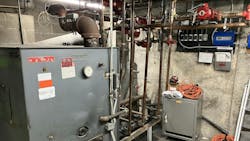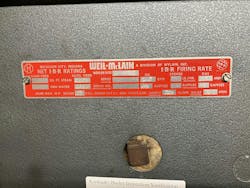Another Day, Another 1950s-Era Hydronic System
I had been counting the days to the end of my chemotherapy treatments and feeling like I was just occupying time and space when the call came in. The feeling like you can’t wait for the day to be over so you’re that much closer to starting a recovery from the side effects. It was one of our company’s highest volume boiler customers, and a good friend for 40 years.
He wanted to meet in a couple of days and I was looking for a distraction to kill some time. The appointment was set on a day with the chemotherapy pump along for the ride. Thankfully, the relationship with the pump is over for now. On to the scan at the end of July.
The address he texted turned out to be in rural Northern Kentucky, not too far out from the suburbs, but with a road name that makes you think of West Virginia, Lower Tug Fork Road. When I got to the address, it turned out to be a Lutheran Church, built in the late 1950’s just up the hill from Tug Fork the steam, in the middle of the God’s countryside.
Pumps, Valves, Zones
The contractor was running late because of road construction on Upper Tug Fork Road, so I went in to meet the representative from the church. We exchanged the usual pleasantries and got to talking about the boiler system you see in the photo, which is pretty typical for the turn of the century.
They liked to have plenty of zones back in the 1950s. This one has five different zones of heating, using five different pumps, all with the important flow control valve to prevent cross circulation and the overheating it can cause in the zones already satisfied.
On most jobs I check to see if the flow control valves are in the operational mode or if they are locked in the manual by-pass mode. With my chemo-fogged brain, I forgot that day. Amazingly, I usually find at least one flow control operating in the manually open mode.
Before I could ask about how the church operates the heating system, the rep started talking, which is great because most times I quote the replacement boiler from the tag info, without detailed info about the system. He had details and was willing to share, the most important point being that the education wing was now on a separate system, and the pump/piping for that zone was valved off.
He continued to tell me that two of the other zones were rarely used and that he would turn the system on once a week on Saturday night to warm the church and basement zones for Sunday services, then shut it off if the predicted outdoor temperatures for the week stayed above 32°F. Last year he stated that the boiler used only $3000 of fuel oil for a full season, which seemed on the low side.
Condensation Issues?
He said everything worked fine, except the boiler leaked water at startup. I immediately thought it might be flue gas condensation since he said the leak came from the back of the boiler and stopped after some amount of run time. But the flue pipe wasn’t showing any signs of rust and jacket below was fine.
Normally flue gas condensation is caused by long boiler run times at low boiler water temperatures. This can be from running on an outdoor reset curve that operates the boiler at temperatures below 140°F or from cast iron radiation systems that have a lot of water volume and therefore take a long time to get up to temperatures above 140°F. I’ve seen it most on standard efficiency copper-fin boilers heating large mass cast iron radiators.
The contractor finally made it to the meeting in the boiler room and we briefed him on the current situation. The boiler wasn’t actively leaking at ambient temperature. It stayed at 12# fill pressure with a dry floor the whole time we were there. The contractor and I have both encountered boilers that leak only at certain temperatures.
He also is not afraid of taking a cast iron sectional boiler apart for inspection. He got on the phone with the local distributor and found out that the O-rings, that seal the sections together in a watertight heat exchanger, were still available. They weren’t sure if the current cast iron section is compatible with the old sections. If a boiler section(s) is bad, then the contractor was going to work with the other distributor. (I’m his high efficiency guy and the other is his cast iron guy.)
Replace or Repair?
The talk now was about taking the boiler apart to inspect the sections for a leak or a seal that is damaged or cast iron sealing surfaces that aren’t allowing the gasket to maintain a seal as the section goes through its temperature increase during operation.
Typically with a boiler that is 50-plus years old, the advice would be to replace rather than attempt repairs. I was planning on quoting a high efficiency hot water boiler, but it would have to be propane fire.
The church rep, however, did not like the idea of changing from fuel oil to propane. For one thing, the oil burner was recently replaced/upgraded. Then you have to consider the way the system would be operated: turn on once a week or so and heat up really fast. That fits the way the existing system is, hot burning fuel oil. The features of a cooler-fire propane modulating condensing boiler would be wasted. They want to run all the time at a low fire to keep the boiler water temperature in line with the outdoor temperature.
I didn’t have anything to quote, which sometimes happens. The job wasn’t going to take up any more of my time, other than the drive. Mach-E take me home!
About the Author
Patrick Linhardt
Patrick Linhardt is a forty-one-year veteran of the wholesale side of the hydronic industry who has been designing and troubleshooting steam and hot water heating systems, pumps and controls on an almost daily basis. An educator and author, he is currently Hydronic Manager at the Corken Steel Products Co.

